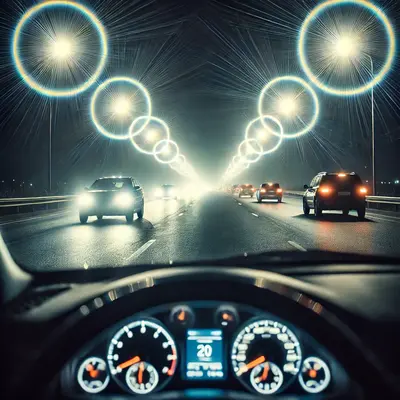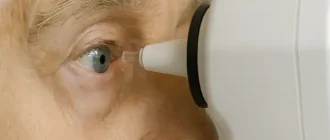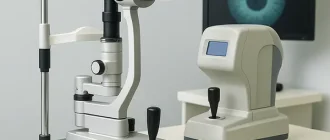When driving at night, some people experience a glowing, ring-like effect around headlights or streetlights. This phenomenon is often referred to as “seeing halos.” While it can seem like a simple quirk of vision, it may be an indicator of an underlying eye condition. Let’s explore what seeing halos at night means, common causes, and when it’s time to seek professional help.
What Are Halos?

Halos are visual disturbances that appear as bright, circular rings around light sources. They are most noticeable at night or in dimly lit conditions when you’re exposed to high-contrast lighting, such as headlights or streetlights. For drivers, this can make nighttime driving more difficult, as the glowing effect can reduce clarity and cause discomfort.
Example:
Imagine you’re driving down a dimly lit highway at night. As an oncoming car approaches, you notice not only the brightness of its headlights but also a large, hazy ring surrounding each light. This glow makes it harder for you to focus on the road ahead and may even cause some discomfort.
Common Causes of Seeing Halos
1. Cataracts
Cataracts, a condition where the lens of the eye becomes cloudy, are one of the most common reasons for seeing halos. As cataracts develop, light entering the eye scatters, creating the halo effect.
Example:
Many people with early cataracts describe halos around headlights as one of the first symptoms they notice when driving at night. Over time, this effect may become more pronounced as the cataract worsens.
2. Glare from Glasses or Contact Lenses
Improperly fitted or dirty glasses and contact lenses can also cause halos. When lenses are not clean or well-positioned, they can scatter light unevenly, creating the ring effect.
Example:
A driver wearing scratched glasses might find that they see halos around streetlights, especially when the lights are bright and the scratches are pronounced.
3. Refractive Errors
Refractive errors like nearsightedness, farsightedness, and astigmatism can affect how light enters the eye. If you’re wearing the wrong prescription, this can result in seeing halos.
Example:
Someone with astigmatism might notice halos when looking at headlights, especially if their glasses prescription is outdated.
4. Dry Eyes
Dry eyes can cause halos by preventing the smooth refraction of light on the surface of the eye. When the eye lacks moisture, light scatters instead of focusing properly.
Example:
A driver with chronic dry eye syndrome may experience halos around headlights, particularly during long drives when the eyes become fatigued.
5. Laser Eye Surgery (LASIK)
After undergoing laser eye surgery, some people experience temporary halos. This is a common side effect that usually resolves itself over time as the eye heals.
Example:
Someone who recently had LASIK might report seeing halos around lights at night for the first few weeks after the procedure.
Impact on Nighttime Driving
Seeing halos while driving can be distracting and dangerous. It reduces contrast sensitivity, which is crucial when navigating dark roads or avoiding obstacles. For some, halos may cause additional eye strain or make it harder to gauge distances between vehicles.
Example Scenario:
| Scenario | Potential Impact |
|---|---|
| Approaching a roundabout at night | Halos may obscure road signs and streetlights. |
| Passing an oncoming vehicle | The glowing effect around headlights could make it harder to judge the car’s distance. |
| Driving in foggy conditions | Halos may worsen visibility, as the fog diffuses the light even more. |
Statistics on Night Vision Problems
According to a report by the American Academy of Ophthalmology, approximately 24 million Americans aged 40 and older are affected by cataracts, one of the leading causes of seeing halos around lights . Additionally, those with uncorrected refractive errors are more likely to experience visual disturbances like halos when driving at night.
When to See a Doctor
If you’re regularly seeing halos around lights at night, especially while driving, it’s important to get your eyes checked. While not all cases of halos are serious, they can indicate conditions like cataracts or glaucoma that require medical attention.
Signs You Shouldn’t Ignore:
- Persistent halos that worsen over time
- Halos accompanied by eye pain or headaches
- Difficulty driving at night or performing other tasks in low-light conditions
Possible Treatments
Depending on the cause, treatment options can vary. If cataracts are the issue, surgery might be recommended. For refractive errors, updating your glasses or contact lenses prescription may reduce the halo effect. In cases of dry eyes, artificial tears or medication may help.
Example of Treatment Options:
| Condition | Treatment |
|---|---|
| Cataracts | Cataract surgery |
| Refractive error | Updated glasses or contacts |
| Dry eyes | Lubricating eye drops |
Conclusion
Seeing halos around headlights or streetlights at night is more than just an inconvenience—it can indicate potential issues with your eyes. If you’re experiencing this symptom frequently, especially when driving at night, it’s worth speaking to an eye specialist to determine the cause and explore possible solutions.
With proper diagnosis and treatment, you can improve your nighttime vision and enjoy safer, more comfortable driving experiences.





